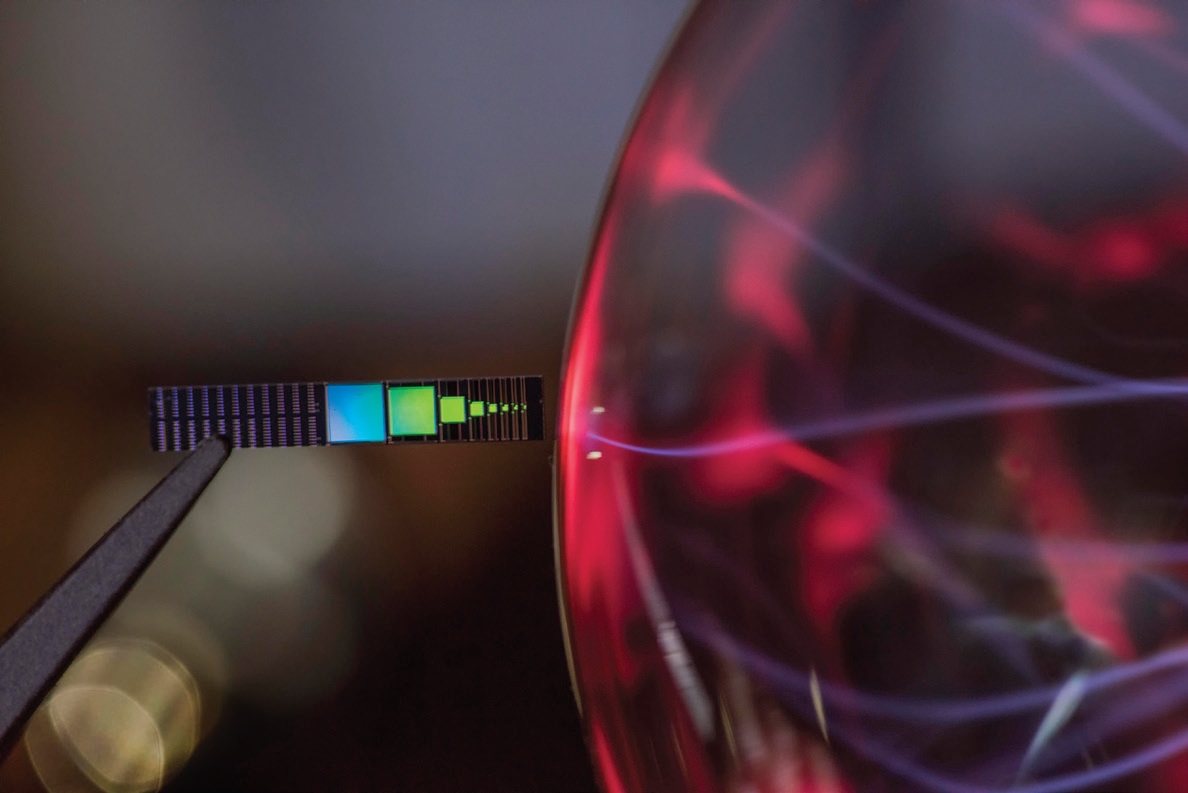KEY CONCEPTS
•
A newly developed solid-state silicon device converts heat into DC electric current.
•
Irradiation of the device, known as an infrared rectenna, causes very rapid electrical oscillations of a thin silicon dioxide layer which produces the DC electric current.
•
One potential application is to convert heat produced by a radioactive thermal source into electricity on the spacecraft.
Inefficiencies in machinery, which lead to the generation of high levels of wasted energy in the form of heat, has led researchers to seek new approaches of transforming heat into useful energy. Thermoelectric devices have been proposed that take advantage of the difference in the temperature between a hot object and the cooler surroundings to generate power.
Last year this column discussed a composite developed by dispersing platinum nanoparticles in a nickel matrix increased transverse thermoelectric performance by a factor of 10 (
1). This result was achieved by utilizing the Seebeck effect to produce a spin voltage from the difference in magnetic properties between the hot and cold end of a ferromagnetic material that is converted into an electrical voltage.
Dr. Paul Davids, physicist at Sandia National Laboratories in Albuquerque, N.M., says, “Thermoelectrics use temperature differences to drive conduction of charge carriers in a semiconductor to create electrical power. Similarly, rectifying antennas have been utilized for wireless power transmission and generation in the microwave spectrum, which has frequencies in the gigahertz range. In order to recover electrical power from radiated waste heat, higher energy conversion needs to be scaled to the infrared region where photons exhibit frequencies in the tens of teraherz range.”
Davids indicated that diodes used in the microwave region to move current are not fast enough for infrared photons. He says, “The infrared region is potentially attractive based on theoretical work, but finding the right type of device is challenging. The current problem with most infrared photodetectors is that cooling is needed, which reduces their effectiveness in converting heat into power.”
Says Davids: “Quantum mechanical tunneling using metal oxide semiconductor tunnel diodes has potential for being used in the infrared region to convert heat into DC power.” Such an approach has now been developed that uses rectification to achieve direct power conversion.
Infrared rectenna
Davids and his fellow researchers have developed a solid-state silicon device that converts heat into DC electric current. This device is a nanoantenna-coupled tunnel diode rectifier known as an infrared rectenna.
The rectenna is prepared with a thin layer of silicon dioxide between an aluminum top and a silicon bottom. This layer is approximately 20 silicon atoms thick or 16,000 times thinner than a human hair. As the rectenna is irradiated, the aluminum guides the infrared photons into silicon dioxide layer where it undergoes very rapid electrical oscillations of about 50 trillion times per second. This is a process called rectification that leads to the generation of the DC electric current.
The device is smaller than a pinkie nail with an active area of three millimeters by three millimeters. Readily available raw materials were used to prepare the solid-state silicon device. An important aspect was to add sufficient materials to dope the silicon without affecting performance.
One other benefit is the rectenna does not have to touch the heat source. It also is made with no moving parts to jam, bend or break. Figure 2 shows an image of the device.
 Figure 2. Researchers took advantage of the higher energy conversion in the infrared region to convert heat into DC electric current through the use of the infrared rectenna shown. (Figure courtesy of Sandia National Laboratories.)
Figure 2. Researchers took advantage of the higher energy conversion in the infrared region to convert heat into DC electric current through the use of the infrared rectenna shown. (Figure courtesy of Sandia National Laboratories.)
The researchers used vacuum radiometry to evaluate the performance of the infrared rectenna. A temperature-controlled ceramic thermal heater is used that is covered by a water-cooled shroud. Davids says, “The thermal heater produced radiation over approximately 90% of the infrared band. This heat source was evaluated at temperatures ranging from 200-450 C.”
By mounting the rectenna to a water-cooled copper block, the researchers were able to generate a temperature difference between the hot thermal source and the cold rectenna. A maximum power density of eight nanowatts per square centimeter was observed at a source temperature of 450 C.
From an application standpoint, Davids foresees that the solid-state silicon device can be used as a radioisotope thermal generator. He says, “We envision that sensors used in space missions can be powered in this fashion because they do not get sufficient sunlight. The source of power for these spacecrafts is a radioactive thermal source, which can get and stay very hot during use. In the vacuum of space, a rectenna should be able to utilize that wasted heat.”
Future work will focus on improving the efficiency of the device. Davids says, “We have developed a prototype that demonstrates this approach will work. Our next objective is to improve the design of the device to achieve greater conversion efficiency.”
The researchers will be looking to replace aluminum to improve the heat differential between the hot source and the rectenna. Davids says, “Aluminum has a melting point of 650 C, which could be an issue if we try to work with higher temperature thermal sources.”
One other suggested improvement is to use a thinner silicon wafer to minimize power loss due to resistance.
Additional information can be found in a recent article (
2) or by contacting Troy Rummler of Sandia National Laboratories at
trummle@sandia.gov.
REFERENCES
1.
Canter, N. (2017), “Transverse thermoelectric device,” TLT,
73 (3), pp. 12-13.
2.
Shank, J., Kadlec, E., Jarecki, R., Starbuck, A., Howell, S., Peters, D. and Davids, P. (2018), “Power Generation from a Radiative Thermal Source Using a Large-Area Infrared Rectenna,”
Physics Review Applied,”
9 (5), 054040.
.